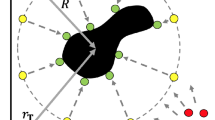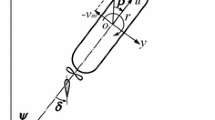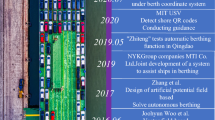Abstract
There is a huge demand to develop a method for marine search and rescue (SAR) operators automatically predicting the most probable searching area of the drifting object. This paper presents a novel drifting prediction model to improve the accuracy of the drifting trajectory computation of the sea-surface objects. First, a new drifting kinetic model based on the geometry characteristics of the objects is proposed that involves the effects of the object shape and stochastic motion features in addition to the traditional factors of wind and currents. Then, a computer simulation-based method is employed to analyze the stochastic motion features of the drifting objects, which is applied to estimate the uncertainty parameters of the stochastic factors of the drifting objects. Finally, the accuracy of the model is evaluated by comparison with the flume experimental results. It is shown that the proposed method can be used for various shape objects in the drifting trajectory prediction and the maritime search and rescue decision-making system.
Similar content being viewed by others
References
BREIVIK Ø., ALLEN A. and CHRISTOPHE M. et al. Wind-induced drift of objects at sea: The leeway field method[J]. Applied Ocean Research, 2011, 33(2): 100-109.
HACKETT B., BREIVIK Ø. and WETTRE C. Ocean Weather Forecasting: An integrated view of oceanography [ M]. Berlin, Germany: Springer-Verlag, 2006, 507–524.
GASTGIFVARS M., LAURI H. and SARKANEN A. et al. Modelling surface drifting of buoys during a rapidly- moving weather front in the Gulf of Finland, Baltic Sea[J]. Estuarine, Coastal and Shelf Science, 2006, 70(4): 567–576
KOD S., MARTIN P. J. and ROWLEY C. D. et al. A real-time coastal ocean prediction experiment for MREA04[J]. Journal of Marine Systems, 2008, 69(1–2): 17–28
ULLMANN D. S., O’DONNELL J. and KOHUT J. Trajectory prediction using HF radar surface currents: Monte Carlo simulations of prediction uncertainties[J]. Journal of Geophysical Research, 2006, 111(C12): 1–14.
DANIEL P., JAN G. and CABIOC’H F. et al. Drift modeling of cargo containers[J]. Spill Science and Technology Bulletin, 2002, 7(5–6): 279–288
ESSEN H. H., BREIVIK Ø. and GUNTHER H. et al. Comparison of remotely measured and modeled currents in coastal areas of Norway and Spain[J]. The Global Atmosphere-Ocean System, 2003, 9(1–2): 39–64
MONBETA V., AILLIOTA P. and PREVOSTOB M. Survey of stochastic models for wind and sea state time series[J]. Probabilistic Engineering Mechanics, 2007, 22(2): 113–126
VANDENBULCKE L., BECKERS J. M. and LENARTZ F. et al. Super-ensemble techniques: Application to surface drift prediction[J]. Progress in Oceanography, 2009, 82(3): 149–167
RIXEN M., FERREIRA-COELHO E. Operational surface drift prediction using linear and non-linear hyperensemble statistics on atmospheric and ocean models[J]. Journal of Marine Systems, 2007, 65(1–4): 105–121
DAVIDSON F., ALLEN A. and BRASSINGTON G. et al. Applications of GODAE ocean current forecasts to search and rescue and ship routing[J]. Oceanography, 2009, 22(3): 176–181
EIDE M., ENDRESEN Ø. and BREIVIK Ø. et al. Prevention of oil spill from shipping by modelling of dynamic risk[J]. Marine Pollution Bulletin, 2007, 54(10): 1619–1633.
HONG S. P., CHO S. J. and PARK M. J. et al. Optimal search-relocation trade-off in Markovian-target searching[ J]. Computers and Operations Research, 2009, 36(6): 2097–2104
NI Z., QIU Z. and SU T. On predicting boat drift for search and rescue[J]. Ocean Engineering, 2010, 37(13): 1169–1179.
BREIVIK Ø., ALLEN A. An operational search and rescue model for the norwegian sea and the north sea[J]. Journal of Marine Systems, 2008, 69(1–2): 99–113
ISOBE A., HINATA H. and KAKO S. et al. Interdisciplinary studies on environmental chemistry marine environmental modeling and analysis [M]. Tokyo, Japan: TERRAPUB, 2011, 239–249.
BREIVIK Ø., SATRA Ø. Real time assimilation of HF radar currents into a coastal ocean model[J]. Journal of Marine Systems, 2001, 28(3–4): 161–182
ABDALLA S., CAVALERI L. Effect of wind variability and variable air density on wave modeling[J]. Journal of Geophysical Research. 2002, 107 (C7): 1–17
NIE H. B. MCMC-based drifting trajectory prediction model and dynamic optimizing ship routeing algorithm[ D]. Master Thesis, Shanghai, China: Shanghai Maritime University, 2013(in Chinese).
Author information
Authors and Affiliations
Corresponding author
Additional information
Project supported by the National Natural Science Foundation of China (Grant Nos. 31100672, 51379121 and 61304230), the Shanghai Key Technology Plan Project (Grant Nos. 12510501800, 13510501600).
Biography: WANG Sheng-zheng (1976-), Male, Ph. D., Associate Professor
Rights and permissions
About this article
Cite this article
Wang, Sz., Nie, Hb. & Shi, Cj. A drifting trajectory prediction model based on object shape and stochastic motion features. J Hydrodyn 26, 951–959 (2014). https://doi.org/10.1016/S1001-6058(14)60104-9
Received:
Revised:
Published:
Issue Date:
DOI: https://doi.org/10.1016/S1001-6058(14)60104-9




